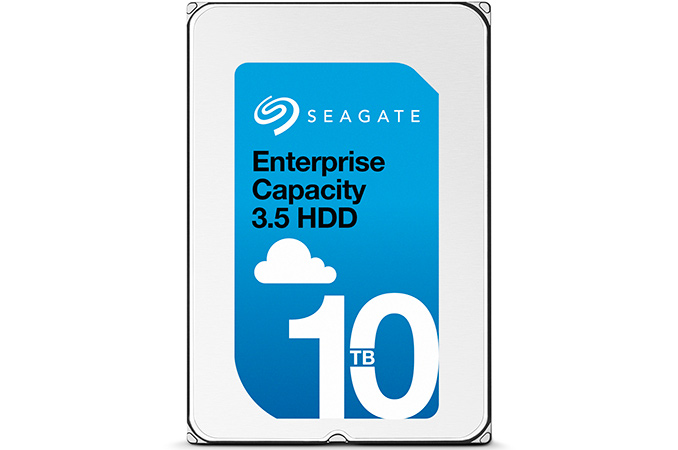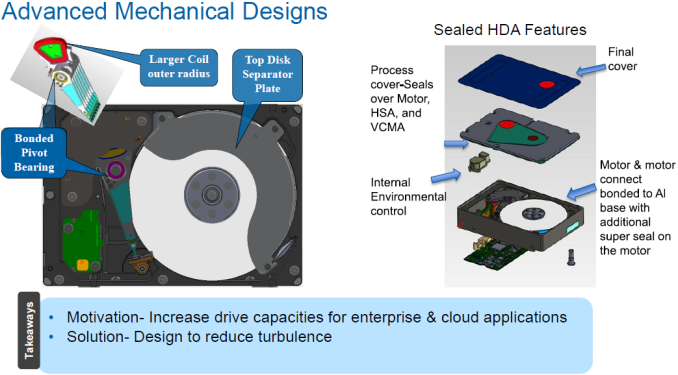Seagate Begins Volume Shipments of Helium-Filled HDDs, Reveals Their Final Specs
by Anton Shilov on April 28, 2016 4:00 PM EST- Posted in
- HDDs
- Seagate
- Helium HDD
- Enterprise Capacity
- 10 TB

Seagate has started volume shipments of its first helium-filled hard drives. They were announced earlier this year. The new HDDs are available to all interested parties, which means that Seagate’s biggest customers have already evaluated and validated them. Volume shipments of the 8 TB and 10 TB helium-filled hard drives will help Seagate to improve its financial results and margins, since the new HDDs will be amongst the most expensive drives in the company’s lineup.
Brand New Platform
The Seagate Enterprise Capacity 3.5 helium-filled hard drive is based on the company’s brand-new hermetically-sealed platform featuring fourteen heads and seven perpendicular magnetic recording (PMR) platters with up to 1.43 TB capacity each. Seagate claims that the new HDD platform is based on a special wide-weld hermetically sealed drive enclosure with a design based on a multi-step forging process. Besides that, it uses a motor attached to both top and bottom covers, in order to better handle vibrations and maximize reliability. Sensors for humidity, temperature and helium pressure ensure that the helium-filled drive is always being monitored for reliable operation.
Seagate has incorporated PowerChoice and PowerBalance technologies in the new drives. PowerChoice helps datacenter operators to manage power consumption during idle time by either reducing spindle speed, or even stopping disks completely, after an admin-defined interval of idle time. Meanwhile, PowerBalance technology helps the administrators to balance the power consumption and IOPS (input/output operations per second) performance of hard drives prior to installation.
The Enterprise Capacity 3.5" helium hard drive sports a 256 MB multi-segmented cache. The platters rotate at 7200 revolutions per minute (RPM). The host interface is SATA 3.2 (6 Gbps), and supports hot-plugging.
Seagate claims that its multi-segmented cache helps the Enterprise Capacity 3.5 (Helium) HDD to improve performance compared to its predecessors and rivals and enables burst transfer rates at up to 600 MB/s (for small chunks of data, of course). The company does not reveal many details about its new caching algorithms, but 256 MB of memory is still a rather huge buffer.
Lineup and Performance Numbers
Seagate will offer multiple versions of its Enterprise Capacity 3.5" Helium HDDs, including models with 8 TB capacity, 4K and 512e sectors as well as self-encrypting (SED) options.
| Lineup of Seagate's Enterprise Capacity 3.5" Helium HDDs with SATA Interface | |||||||
| Standard 4KN | Standard 512e | Self-Encrypting 4KN (SED) | Self-Encrypting 512e (SED) | ||||
| 10 TB Capacity | ST10000NM0006 | ST10000NM0016 | ST10000NM0056 | ST10000NM0046 | |||
| 8 TB Capacity | ST8000NM0006 | ST8000NM0016 | ST8000NM0056 | ST8000NM0046 | |||
Seagate declares fairly high performance numbers for its Enterprise Capacity 3.5" Helium HDDs: 243 or 254 MB/s maximum sustained transfer rate as well as 4.16 ms average latency, which is higher than the numbers listed by competing drives from HGST and Western Digital.
| Comparison of Helium-Filled HDDs | ||||||
| Seagate Enterpise Capacity ST10000NM0006 |
HGST Ultrastar He10 HUH721010ALE600xxxx |
WD Gold WD8002FRYZ |
||||
| Capacity | 10 TB | 8 TB | ||||
| RPM | 7200 RPM | |||||
| Interface | SATA 6 Gbps | |||||
| DRAM Cache | 256 MB | 128 MB | ||||
| Maximum Sustained Transfer Rate | 243 MB/s 254 MB/s |
225 MB/s 249 MB/s |
205 MB/s | |||
| Average Latency | 4.16 ms | unknown | ||||
| Rated Workload (Drive Writes Per Day) | 0.189 | unknown | 0.189 | |||
| Equivalent of 550 TB of Writes per Year | unknown | Equivalent of 550 TB of Writes per Year | ||||
| Acoustics | Idle | 28 - 30 dBA | 20 - 36 dBA | 20 dBA | ||
| Seek | 32 - 34 dBA | unknown | 36 dBA | |||
| Power Rating | Idle | 4.5 W | 5 W | 5.10 W | ||
| Random Write | 6.5 W | 6.8 W | 7.4 W | |||
| Random Read | 8.5W | 6.8 W | 7.4 W | |||
| MTBF | 2.5 million hours | |||||
| Warranty | 5 Years | |||||
| Price | $695 at Amazon | unknown | $629 | |||
Usage of helium inside a hard drive helps to reduce the drag force acting on the spinning disk stack and lower the fluid flow forces affecting the disks and the heads. As a result, HDD makers can install up to seven platters into a standard drive and also use lower-power motors and mechanics. This reduces the power consumption of the HDDs. For example, power consumption of Seagate’s 10 TB hard drive is actually lower than power consumption of the company’s 8 TB drive for nearline applications (8.5 W per drive vs. 10.4 W per drive).
For cloud datacenters, power consumption of HDDs is as important as their capacity. Increasing the capacity of the top-of-the-range hard drives from 8 TB to 10 TB automatically boosts total capacity per rack by 25% (which means an increase from 1920 TB to 2400 TB per standard rack that holds 240 drives). Going helium additionally reduces the power consumption of such a rack by up to 456 W. An increase of storage capacity amid reduction of power consumption not only maximizes data storage capacities of a particular facility, but also shrinks its total cost of ownership (TCO), an important metric for companies with multiple large datacenters.
Broad Availability, But No SAS Models Yet
It should be noted that when Seagate introduced its Enterprise Capacity 3.5" 10 TB HDD in January, the company announced models with Serial ATA 6 Gb/s and SAS 12 Gb/s interfaces, which were aimed at different environments. At present, Seagate only ships models with SATA interfaces, meaning that customers, who need SAS, may still be evaluating SAS drives, which will come to market later. By contrast, HGST offers different models of its 10 TB HDDs: with SATA and SAS interfaces.
While Seagate said that its 10 TB helium-filled HDDs are available from its distributors worldwide, it did not reveal their actual prices. Amazon currently sells the Seagate Enterprise Capacity 3.5" HDD 10TB (ST10000NM0016) for $695.98 (note that this is not an MSRP), which is far from affordable. Still, keep in mind that we talking about exclusive products based on a brand-new platform. Such HDDs make a lot of sense for datacenters, but, currently, not so much for desktops or NAS units.
Source: Seagate











65 Comments
View All Comments
ddriver - Thursday, April 28, 2016 - link
LOL, seagate doesn't dare offer more than 2 years on anything but "enterprise" grade. I wonder if they really have confidence in those products, or merely priced them twice as high as normal, so you are effectively buying two drives at once - the one you are gonna get right away and the one they will send for a replacement when it fails.takeshi7 - Monday, May 2, 2016 - link
I don't get your point. WD has a 2 year warranty on a lot of their products too.Alexvrb - Thursday, May 5, 2016 - link
If by "a lot of their products" you actually mean ONLY their entry-level bottom-line conventional Blue series, you're right. In their current lineup that's the only thing with a 2-year warranty. The Blue SSHD, standard Red, WD AV, and Purple series all carry a 3-year warranty. Their Red Pro, Black, and VelociRaptor series have a 5 year warranty. That's obviously not counting Enterprise-focused series which all carry a 5 year warranty except the Cold Storage Ae series which is still 3 years.Facts aside I might be biased because the majority of hard drive failures I've seen or dealt with have been Seagates, with the exception of a particular series of Deskstars which thankfully was not a mistake they repeated (later-gen designs after that were very solid). I also had great luck with Fujitsu, and was a bit sad to see them snatched up by Toshiba. So goes the shrinking HDD universe.
Donkey2008 - Saturday, May 7, 2016 - link
Ditto. I have RMA'd so many Seagate laptop drives that I don't even bother anymore and just replace them with Mushkin SSDs. Same goes for garbage Hynix memory modules. Dell fills their product line with these junk brands.takeshi7 - Wednesday, May 11, 2016 - link
The equivalent of the WD Red is the Seagate NAS HDD. It has a 3 year warranty.The equivalent of the WD Purple is the Seagate Surveillance HDD. It has a 3 year warranty.
The equivalent of the WD AV is the Seagate Video HDD. It has a 3 year warranty.
The equivalent of the WD Red Pro is the Seagate Enterprise NAS HDD. It has a 5 year warranty.
The only ones Seagate doesn't have an equivalent for that you listed is the WD VelociRaptor and the WD Black. On every other one of their products they have the same warranty as WD.
takeshi7 - Wednesday, May 11, 2016 - link
Oh, I just learned the equivalent to the WD Black is the Seagate Enterprise Capacity HDD. It has a 5 year warranty. Your argument is invalid.boeush - Thursday, April 28, 2016 - link
So... If they can manage to hermetically seal in Helium, why not go the extra mile and just hermetically seal a vacuum? Surely, platters/heads moving in near-total absence of any gases at all would require even less power? And it's not as if the task if maintaining a vacuum seal in the face of a single atmosphere's worth of external pressure is all that insurmountable: vacuum thermoses have been around for nearly a century -https://en.m.wikipedia.org/wiki/Vacuum_flask
CaedenV - Thursday, April 28, 2016 - link
Because the heads ride on a cushion of air that prevents them from crashing into the platter. If you had a vacuum then the slightest vibration would cause a head crash and destroy the drive.FunBunny2 - Thursday, April 28, 2016 - link
-- Because the heads ride on a cushion of air that prevents them from crashing into the platter.it's even more obvious: sealing HE in a case at atmospheric pressure is no big deal, while sealing a vacuum against atmospheric pressure certainly is.
HollyDOL - Friday, April 29, 2016 - link
Also, with vacuum you'd have to sustain constant outer pressure on the component at 100kPa... With vacuum you are getting to a completely different league in all steps - sealing, venting, cover pressure resistance, heads "gyroscope" thing you'd need to have and lots of other things I can't even think of :-)